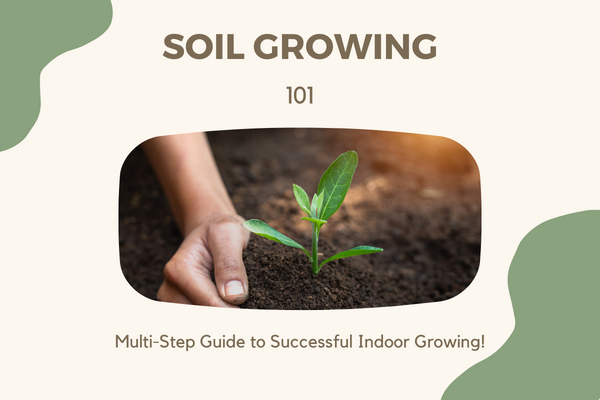
Indoor Soil Growing 101 - A Multi-Step Guide to Successful Indoor Growing
Growing cannabis is therapeutic and enlightening and doesn’t have to be as difficult as you imagined. Many individuals across the US and Canada have been reaping the rewards of growing their own cannabis for years, producing high quality buds & extracts, at an affordable cost. Here are 7 Steps to successful indoor growing.
Base: Often Peat or Coco Fiber or some combination
Aeration Component: Perlite, Vermiculite, Lava Rock, or Rice Hulls
Supplemental biological additive: Compost or Worm Castings
Fertilizers: Organic Amendments like Bone Meal and Kelp, or Synthetic Fertilizers
Choose a Potting Mix
• Potting Mixes are typically peat-based mixes with perlite and other materials that unlike soil, are light weight and have great air/water holding properties
• Sphagnum Peat Moss is naturally acidic and often used with dolomite lime to raise pH
• Perlite is a coarse substrate derived from volcanic rock and used to improve drainage/aeration
• Coco is made from the husks of a coconut, is pH stable, and provides moisture retention/aeration
• Worm Castings and Composted Waste add beneficial biology that help plants access nutrients in the soil
The Right Environment
• Key components include relative humidity, temperature, CO2, and air circulation/exchange
• Ideal humidity is between 40%-60%
• Some plants like higher humidity, but that can lead to problems with fungus and disease
• Ideal temperature is between 68-75F
• Plants need CO2 to grow - with good air circulation and exchange, a room will naturally have between 300-400 PPM without supplemental CO2
Start With Good Water
• Water quality is essential to plant growth
• PPM (parts per million) or EC (electrical conductivity) measures salts in a solution
• Start off with a low PPM or EC and add nutrients specific to your plant variety requirements
• A Reverse Osmosis system can reduce PPM/EC
• pH (potential hydrogen) measures acidity or alkalinity in a solution on a scale of 0-14
• pH should range 5.8-6.2 in hydro and 6.0-6.8 in soil
• Nutrient "lockout" occurs in too high or low pH levels
Nutrients/ Fertilizers
• Liquid/Dry nutrients can be organic or synthetic
• Over or under fertilizing can cause burning, curling, or yellowing of plants
• Most nutrient bottles are labeled with N-P-K (Nitrogen, Phosphorous, and Potassium)
• Additives/supplements can bolster microbial activity at the root zone, strengthen plant cell walls, increase flower sites, shorten length to harvest, increase size, flavor and aroma of fruits and flowers and more
• When used together, nutrients and supplements will help you achieve maximum results
Grow Lighting
• MH (Metal Halide) and HPS (High Pressure Sodium) are types of HID lights used in grow rooms
• MH lamps = Blue spectrum for vegetative
• HPS lamps = Orange/Red spectrum for flowering
• T5 lamps are high-output fluorescents with low heat/energy consumption ideal for cuttings, mother plants, and short growth cycles
• DE (Double Ended) lighting is a full spectrum HID lamp with a higher par reading than single ended
• Plants in vegetative stage need 15-18 hrs. of light
• Plants in bloom stage need 10-12 hrs. of light
Testing Equipment
• There are many meters available for testing solution pH, PPM, and EC
• Environmental controllers and meters are available to automate and more accurately control and maintain the temperature, humidity, CO2 and lights
• Testing equipment for the water-nutrient solution, light, room temperature and humidity, CO2, and air circulation is the key to providing optimal conditions for a bountiful garden
Optional Accessories
• Grow/Garden room accessories are essential for optimized growth and harvest
• Atmosphere drive devices such as fans, blowers, CO2 emitters, and integrated timers are a grow rooms greatest accessory
• Trellising, stakes, supports, shears, and labels are useful when growing fruiting/flowering crops
• Pest and disease control may be needed and there are many organic options available
No posts found
Write a review
